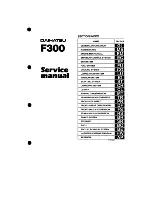
Your vehicle has two-stage front air bags.
During the first deployment stage, the front
air bag is filled with propellant gas to reduce
the risk of injuries. The front air bag is fully
deployed with the maximum amount of pro-
pellant gas if a second deployment threshold
is reached within a few milliseconds.
The activation threshold of the Emergency
Tensioning Devices and the air bag are deter-
mined by evaluating the rate of vehicle decel-
eration or acceleration which occurs at vari-
ous points in the vehicle. This process is pre-
emptive in nature. Deployment should take
place in good time at the start of the collision.
The rate of vehicle deceleration or accelera-
tion and the direction of the force are essen-
tially determined by:
R
the distribution of forces during the colli-
sion
R
the collision angle
R
the deformation characteristics of the vehi-
cle
R
the characteristics of the object with which
the vehicle has collided
Factors which can only be seen and measured
after a collision has occurred do not play a
decisive role in the deployment of an air bag,
Nor do they provide an indication of air bag
deployment.
The vehicle can be deformed considerably,
without an air bag being deployed. This is the
case if only parts which are relatively easily
deformed are affected and the rate of decel-
eration is not high. Conversely, air bags may
be deployed even though the vehicle suffers
only minor deformation. This is the case if, for
example, very rigid vehicle parts such as lon-
gitudinal body members are hit, and sufficient
deceleration occurs as a result.
If the restraint system control unit detects a
side impact or that the vehicle is rolling over,
the relevant restraint system components are
activated independently of one another
depending on the apparent type of accident.
If the system determines a need for additional
protection for the vehicle occupants, the
Emergency Tensioning Devices are triggered.
R
Side impact air bag on the side of impact,
independently of the Emergency Tension-
ing Device and the use of the seat belt on
the driver's seat
The side impact air bag on the front-
passenger side deploys under the following
conditions:
-
the OCS system detects that the front-
passenger seat is occupied or
-
the belt tongue is engaged in the belt
buckle of the front-passenger seat
i
Not all air bags are deployed in an acci-
dent. The different air bag systems work
independently of each other.
How the air bag system works is deter-
mined by the severity of the accident detec-
ted, especially the vehicle deceleration or
acceleration and the apparent type of acci-
dent:
R
frontal collision
R
side impact
R
rollover
PRE-SAFE
®
(anticipatory occupant
protection system)
Introduction
In certain hazardous situations, PRE-SAFE
®
takes pre-emptive measures to protect the
vehicle occupants.
Important safety notes
!
Make sure that there are no objects in the
footwell under or behind the seats when
moving the seats back. There is a risk that
Occupant safety
55
Saf
ety
Z
Summary of Contents for GT S 2016
Page 4: ......
Page 70: ...68...
Page 88: ...86...
Page 98: ...96...
Page 160: ...158...
Page 184: ...182...
Page 185: ...Useful information 184 Stowage areas 184 Features 186 183 Stowage and features...
Page 200: ...198...
Page 210: ...208...
Page 268: ...266...
Page 269: ...267...
Page 270: ...268...
















































